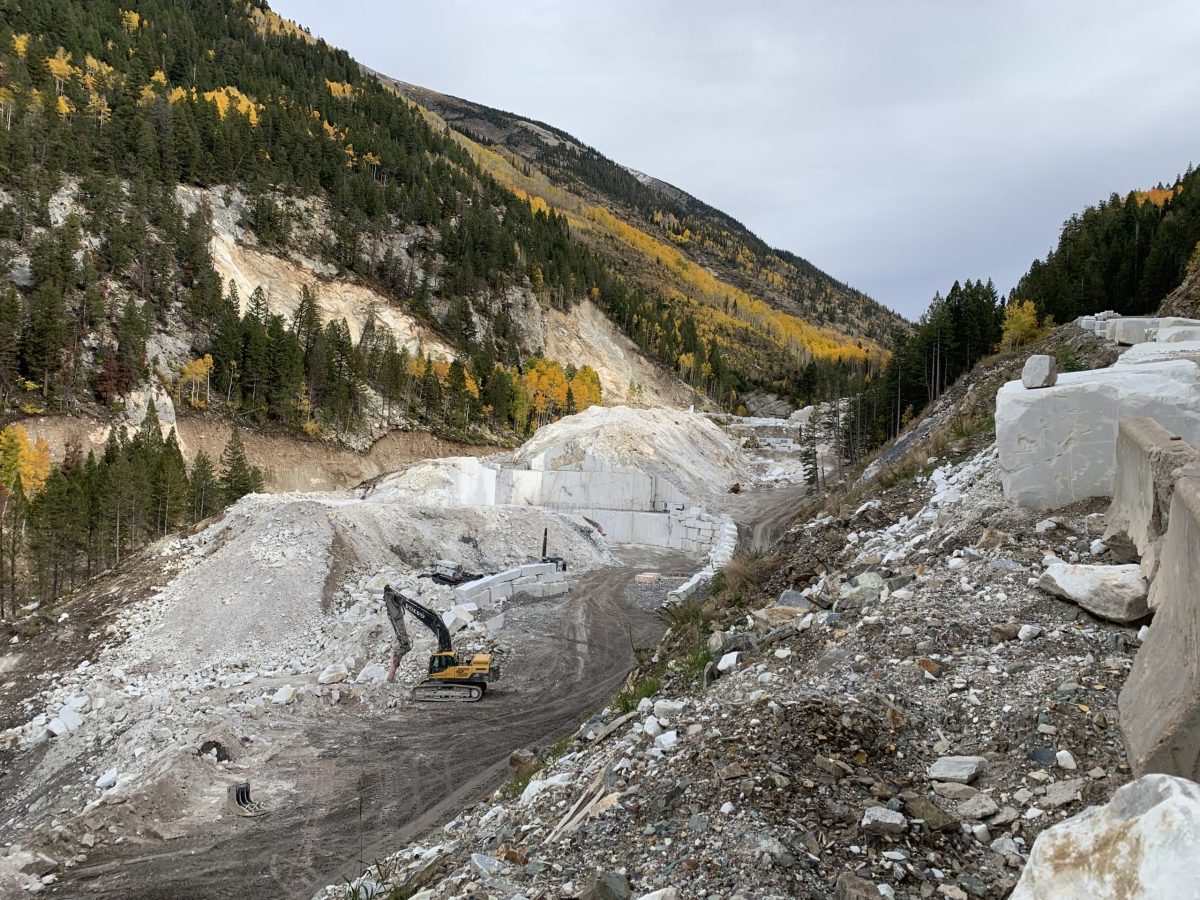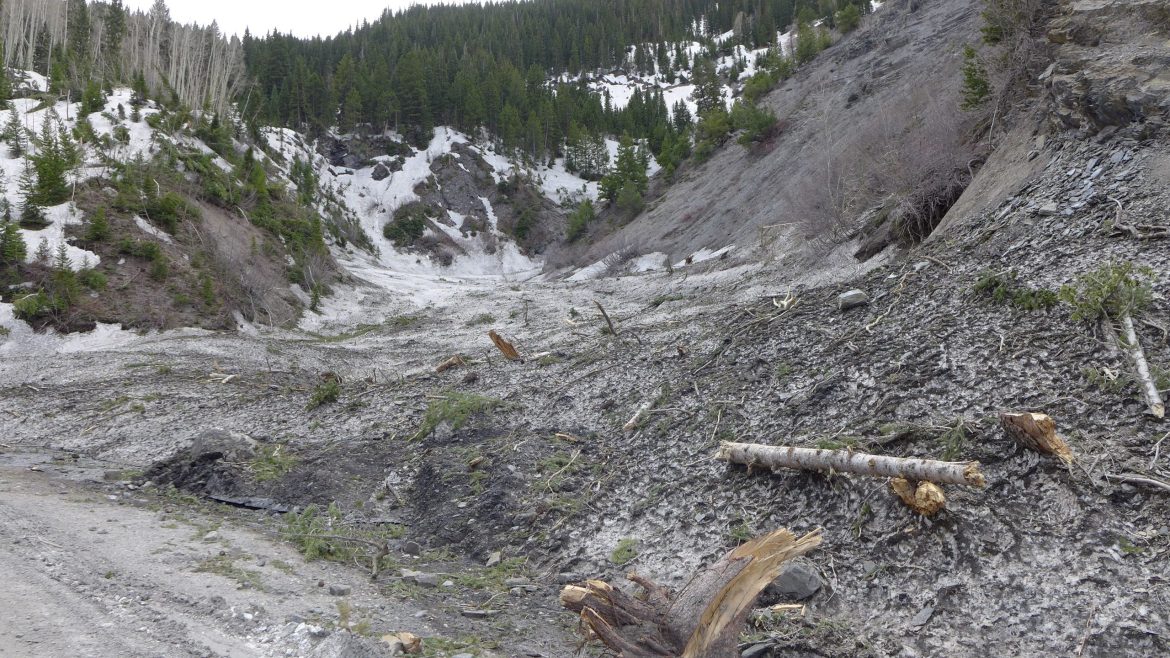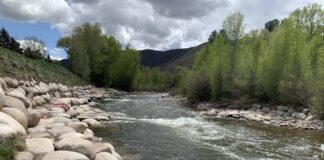
MARBLE —As a fix for violating the Clean Water Act in 2018, the operators of a local marble quarry must construct a culvert and bridge and rehabilitate the stream they illegally diverted, according to the U.S. Army Corps of Engineers.
Colorado Stone Quarries, which operates the Pride of America Mine perched 3 miles above the town of Marble on County Road 3C, diverted Yule Creek, a tributary of the Crystal River, into a new channel to make way for a mining road without first obtaining a permit from the U.S. Army Corps of Engineers.
As compensatory mitigation required by the Army Corps, the mining company will have to improve and monitor for five years the affected stretch of Yule Creek. CSQ will also need to make major improvements to a culvert and a bridge where the Mud Gulch drainage intersects County Road 3C, about six-tenths of a mile downhill from the quarry.
These are two of 10 special conditions that the mining company must meet as part of its 404 individual permit issued by the Army Corps in February. The Mud Gulch work must be approved by Gunnison County and the U.S. Forest Service, and must be completed by February 2024.
Ben Wilson, project manager with the Army Corps, said the new 72-inch-diameter culvert and bridge will allow sediment to flow more easily under the road and down Mud Gulch, which is prone to mudslides. Mud Gulch intersects with Yule Creek downstream from the quarry and upstream of Yule Creek’s confluence with the Crystal River.
“They are reworking it almost completely to be a flow-through system that offers an ecological benefit of restoring that section of stream,” Wilson said. “It’s all about offsetting the ecological functional loss that was associated with the main project.”
The mining company said the Army Corps required them to choose compensatory mitigation that was “in-kind” to the impacts on Yule Creek and as close as possible to the affected area.
“Improvements to the Mud Gulch area will return the drainage back to its original flow path and provides a solution that is mutually beneficial to Gunnison County, the (Army Corps), the USFS and CSQ’s neighbors along County Road 3C,” CSQ General Manager Jean St. Onge said in an email. “These benefits will positively impact the wildlife and vegetative communities of the Yule Creek Valley.”
St. Onge said the construction work on Mud Gulch and Yule Creek stream restoration will begin in late summer or early fall.
In the fall of 2018, CSQ diverted about 1,700 linear feet of Yule Creek from its natural channel — located on the west side of Franklin Ridge, a rock outcropping — to the east side of the ridge. Operators used explosives to fill the original western channel with 97,000 cubic yards of material, including marble blocks.
Although this move probably spared Yule Creek the impacts of a diesel spill in October 2019, it was done without the proper permits or oversight, which the Army Corps determined violated the Clean Water Act.
Under Section 404 of the Clean Water Act, a project requires a permit from the Army Corps if it includes the discharge of dredged or fill materials into waters such as rivers, streams and wetlands. This is the permit that the Army Corps recently retroactively issued to CSQ, which contains the 10 special conditions.

Yule Creek will remain in new channel
When the violation first came to the attention of the Army Corps, there was discussion about whether CSQ should return the stream to its original channel or leave it in the new eastern alignment. CSQ argued that it should remain in the new alignment, and the Army Corps agreed. Wilson said leaving Yule Creek in the eastern channel is what the agency calls the Least Environmentally Damaging Practicable Alternative, or LEDPA, which still allows CSQ to meet its project goals.
“We understand that leaving it in place is probably ecologically better now that it has already occurred,” he said.
CSQ will have to do ecological enhancement on the new stream channel by adding woody debris, creating pools and riffles, and planting willows, and then will have to monitor the channel for five years.
According to the other special conditions of the permit, CSQ also has to comply with state water-quality standards, post additional financial assurance to the tune of $235,430, submit annual reports to the Army Corps and implement an agreement with the State Historic Preservation Office, which includes adding interpretive signage in the form of bronze panels detailing the historic significance of the quarry.
To further compensate for the loss of aquatic resources, CSQ must establish a total of 11 acres of a preserved buffer along part of the creek where no further human disturbance can occur.
St. Onge said CSQ is committed to following each of the special conditions required by the Army Corps.
Environmentalists disappointed
Pitkin County and local environmentalists questioned whether the mitigation meets the requirements of the Clean Water Act and goes far enough to make up for the damage to Yule Creek. John Armstrong, president of the Crystal Valley Environmental Protection Association, said the conditions of the Army Corps permit are woefully inadequate in addressing the gravity of the situation.
“It just encourages the philosophy to ask forgiveness instead of permission to do things right in the first place,” Armstrong said. “It’s a real affront to the environmental community.”
He said the Mud Gulch area is a low priority for CVEPA and he would have liked to see mitigation occur at one of a number of sites downstream in the Crystal River Valley that need improving. In December 2020, CVEPA, along with Pitkin County and other groups, submitted comments to the Army Corps suggesting possible areas for restoration.
Kate Hudson, a resident of the Crystal River Valley and western U.S. coordinator for Waterkeeper Alliance, agreed. She said the requirements may not be enough to deter future violations or potential violators.
“I am very concerned that at the end of the day, what this company has been required to do by the Army Corps is not going to be sufficient to instill respect for our laws that are designed to protect our waterways.”
Pitkin County Attorney Laura Maker questioned whether the mitigation meets the requirements of the Clean Water Act.
“Whether or not (the Mud Gulch project) represents the best for the watershed, I don’t think that has been fully vetted,” she said.
The quarry site and Yule Creek are in Gunnison County, but the creek is a tributary of the Crystal River, which flows through Pitkin County.
The Pride of America Mine, known locally as the Yule Quarry, has been the source of marble for many well-known monuments, including the Lincoln Memorial, the Tomb of the Unknown Soldier and the Colorado Capitol. In 2016, the state Division of Reclamation, Mining and Safety granted the quarry a permit for a 114-acre expansion for a total of 124 permitted acres. CSQ officials say there is enough marble in its quarries to continue mining at the current rate for more than 100 years.
Aspen Journalism covers water and rivers in collaboration with The Aspen Times. This story ran in the May 14 edition of The Aspen Times.
The Water Desk’s mission is to increase the volume, depth and power of journalism connected to Western water issues. We’re an initiative of the Center for Environmental Journalism at the University of Colorado Boulder. The Water Desk launched in April 2019 with support from the Walton Family Foundation. We maintain a strict editorial firewall between our funders and our journalism.





